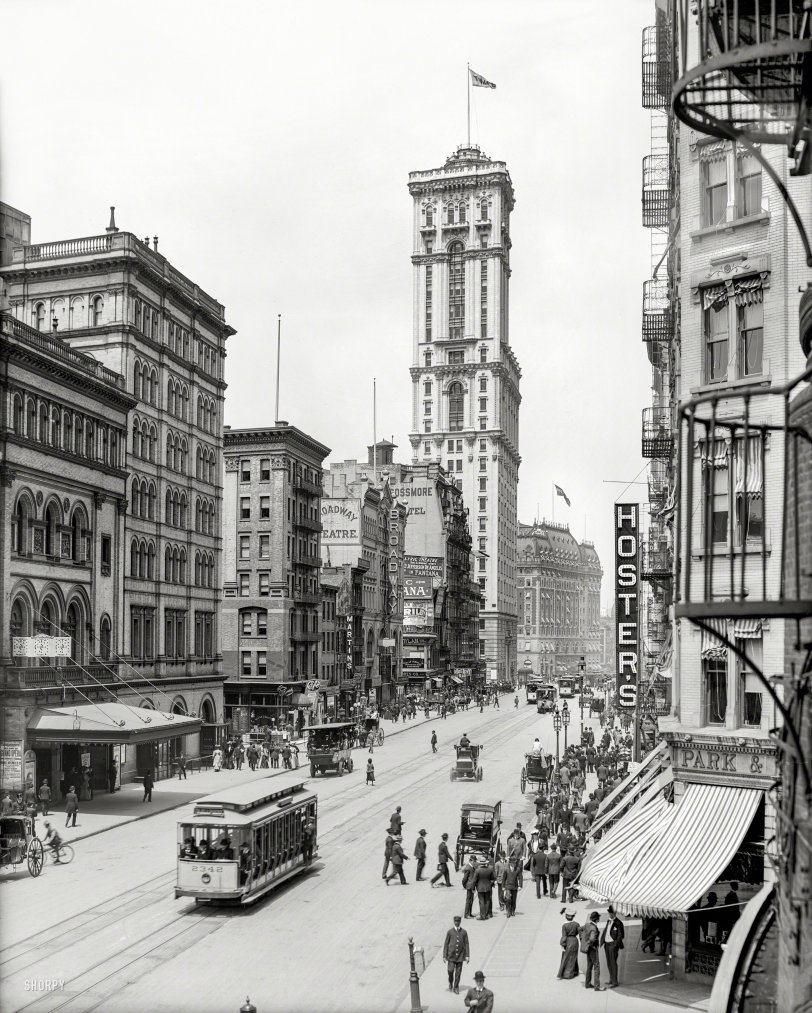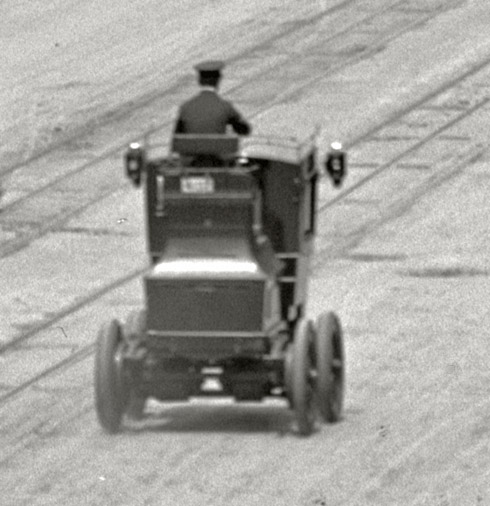


Framed or unframed, desk size to sofa size, printed by us in Arizona and Alabama since 2007. Explore now.
Shorpy is funded by you. Patreon contributors get an ad-free experience.
Learn more.

- Baldwin 62303
- Baldwin VO-1000
- Cold
- No expense spared
- Tough Guys
- Lost in Toyland
- And without gloves
- If I were a blindfolded time traveler
- Smoke Consumer Also Cooks
- Oh that stove!
- Possibly still there?
- What?!?
- $100 Reward
- Freeze Frame
- Texas Flyer wanted
- Just a Year Too Soon
- WWII -- Replacing men with women at the railroad crossing.
- Yes, Icing
- You kids drive me nuts!
- NOT An Easy Job
- I wonder
- Just add window boxes
- Icing Platform?
- Indiana Harbor Belt abides
- Freezing haze
- Corrections (for those who care)
- C&NW at Nelson
- Fallen Flags
- A dangerous job made worse
- Water Stop
Print Emporium
On Broadway: 1905

New York circa 1905. "Broadway and Times Building (1 Times Square)." 8x10 inch dry plate glass negative, Detroit Publishing Company. View full size.
One Times Square
I work across the street from One Times Square, and I've often thought how sad it is that you can't see the building anymore! it's so covered in electronic signs, large billboards, and other metal sheet covering, that you can't see the underlying building anymore. It looks like a handsome structure, but it's all hidden way.
Metropole
The Metropole Hotel at 43rd Street. The first hotel in NYC with running water in every room.
From this exact location
It would be amazing to see a pic from 100 years later taken from the same or even close spot and placed side by side for comparison.
Re: What is that?
I believe that the mysterious electric sign in question was a cab call sign, which lit up with numbers to show how many cabs were being requested by opera patrons after a show. These signs seem to have hung on many NYC theaters and hotels back around the turn of the century. There is still an existing (but, alas, apparently not functioning) one hanging on the front of the St. Regis Hotel on 55th Street.
Fantana
NY Times review of Jefferson DeAngelis in "Fantana" at the Lyric Theater.
Trilby
Note the billboard advertising the play "Trilby." The popularity of this play (adapted from an 1894 novel) is what gave us the term Svengali and also the Trilby hat.
Vehicular Variety
Carriages, hackney cabs (when was the last time those were seen in NYC?), electric cars, some sort of electric wagon full of sightseers, at least five trolley cars, a horse-drawn wagon carrying passengers (a bit like a hayride), a farm wagon, and a bicycle - not to mention the sheer volume of walkers of all ages and costumes. This is the age of Wharton, Dreiser and Howells. (It's also the age of the muckrakers and Jacob Riis' exposes.)
The women's Edwardian hats and skirts are so luxurious! This was about five years before the introduction of the hobble skirt, which was tightly constricted at the bottom. Women could still sweep down the sidewalk regally in 1905, and often their hats plowed the crowd before them like the figurehead on a schooner.
The female cutting across the street in a short skirt and wide-brimmed hat is probably a teenager. Edwardian girls continued to wear short skirts until they "came out" into society or reached the age of 18. Skirt lengths for women wouldn't begin to creep up off this floor until 1915; the Great War made a fashion out of the necessity of less fabric available for women's skirts. "Flapper" style wouldn't begin until the hedonistic post-War late 'teens.
I often wonder if a similar photo, taken today from the same perspective, will similarly show a quaint and vanished cityscape to the citizens of 2110. Will they gape at the volume of gasoline-powered individual autos on our streets?
What is that?
Maybe I'm missing something obvious, but for the life of me I can't figure out what that thing is on the left, above the balcony. It looks like three squares covered with dots and topped by a flourish. I can't tell if it's attached to the awning wires or hanging from the side of the building.
[It's an electric sign. Similar to the one seen on the New Montauk Theater. - Dave]

E-cab
So, an electric hansom cab operated by a coachman from the traditional topside perch -- bizarre!
[Below, an excerpt from he book "Taxi!" by Graham Hodges. - Dave]
Electric cabs had showed some promise; since July of 1897, twelve electric hansom cabs had plied the [New York] city streets. Organized by the Electric Carriage and Wagon Company, these novelty cabs competed with horse-drawn hacks. Despite their technological innovation, called by Scientific American in a March 1909 article "one of the most significant facts of city transportation," electric cabs varied only slightly in performance and appearance from horse-drawn vehicles. Scientific Magazine preferred the electric cab because it was silent and odorless. Even though the Electric Vehicle Company expanded its New York fleet to sixty-two in 1898 and then to one hundred the next year, its overall success was short-lived. Electric cabs were cumbersome, were unable to move faster than fifteen miles per hour, and required a battery recharge every twenty-five miles that took eight hours to complete. This problem limited use of electric taxis to single rides and made cruising impossible. Changing a battery also required use of an overhead crane and a spacious garage. Replacing the pneumatic tires required taking off the entire wheel disk, which caused further delays. Despite the clean and silent operation, passenger comfort was minimal. Fares sat in an open seat in the front of the cab, while the driver perched overhead. The brakes were applied forward, which in emergency situations meant that the entire car might topple over. Not surprisingly, electric cabs did not catch on. One contemporary writer observed that many people took one ride but rarely returned for a second, preferring horse-drawn hacks. A fire settled the issue. In January 1907, the Electric Carriage and Wagon Company went under when three hundred of its cabs burned in a garage fire.
Or maybe not. More here.

Future Flappers of America
All of the women in this photo have floor length shirts except the one crossing in the middle of the street. Jaywalking and a short skirt--nothing less than scandalous.
Tally Ho
There's another one of those beasts of an electric tour bus lumbering down Broadway. I wonder if Hoster's is the precursor of Hooters?
Aria landmark
Left foreground is Metropolitan Opera House -- a.k.a. the old brewery, demolished 1967.
The hats
There had to be one guy in a million who defied convention and dared venture outdoors hatless, but I've yet to spot him in these kind of scenes.
Electric
Electric street lights, electric signs, an electric hansom cab, an electric charabanc, what a wonderful world. Are the trams underground electric ones or are they cable cars?
[The streetcars are electric. - Dave]
























On Shorpy:
Today’s Top 5